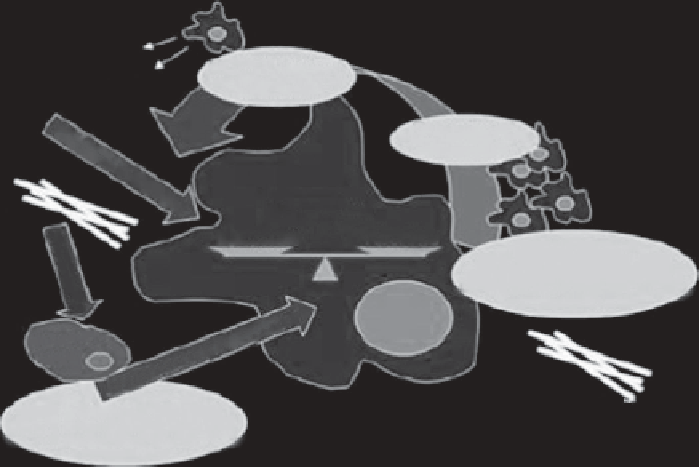Biomedical Engineering Reference
In-Depth Information
O
2-
O
2-
H
2
O
2
NADPH oxidase
activation
OH
-
Recruitment
of new MΦ
Cell death
Apoptosis
CNT
Necrosis
Production of
proinflammatory cytokines
Apoptotic
cell
CNT
Production of
proinflammatory cytokines
FIGURE 20.6
In the lung, the initial target for CNTs is probably type I epithelial cells whose necrotic death
stimulates a proinflammatory response and recruitment of inflammatory cells. Interactions include oxidative
burst due to activation of NADPH oxidase and possible interactions of nanoparticles with microbial patho-
gens. NADPH oxidase complex is activated in macrophages during inflammation and it acts as the major
source for the generation of reactive oxygen species, such as superoxide O
2
-d radicals that disproportionate to
form hydrogen peroxide (H
2
O
2
). Transition metals, through their interactions with O
2
-d and H
2
O
2
, act as cata-
lysts for the formation of highly reactive hydroxyl (OH
−
) radicals. Oxidatively modified lipids generated by
cyclooxygenase (COX-2) and lipooxygenase (LOX) participate in amplification of the inflammatory response
via recruitment of new inflammatory cells. (From Yu Y. et al.
Nanoscale Research Letters
2 0 0 8;3:271-7.)
There are several factors that regulate the distribution of nanomaterials through the respiratory
tract, such as their chemical reactivity with body proteins, the size or surface characteristics, and
so on. CNTs can escape clearance by macrophages and pass from the alveoli to the blood circula-
tion followed by migration to different organs of the body. Physical attributes such as size, surface
modifications, and so on play a crucial role in extrapulmonary translocation of CNPs. Following
the deposition of CNPs, they are translocated to extrapulmonary sites, from where they reach the
circulatory system via transcytosis. Removal of these deposited particles may take place by both
physical and chemical translocation processes. The soluble components of NPs either in lipids or in
intracellular fluid undergo absorption into protein or subcellular components, or into extracellular
fluids. Owing to biodistribution of CNPs, they may reach the liver and even central nervous system
after entering the body through inhalation. Alveolar macrophages form the first line of defense
against NPs entering the lungs. A dose-dependent increase in inflammatory response has been
observed with SWCNTs. Aggregated CNTs can form granulomatous inflammation, including dis-
crete granulomas with hypertrophic epithelial cells in the lungs. CNPs are mostly eliminated from
the body by macrophages through phagocytosis. But the ones that are not removed by phagocytosis
penetrate epithelial cells and/or find their way into interstitial spaces, finally entering into systemic
circulation and the lymphatic system.
20.13.1 e
ffects
oN
l
uNgs
Different types of NPs can induce diverse inflammatory responses in the lung. For instance, owing
to the toxicity of SWCNTs, epithelioid granulomas and interstitial inflammation were observed in

